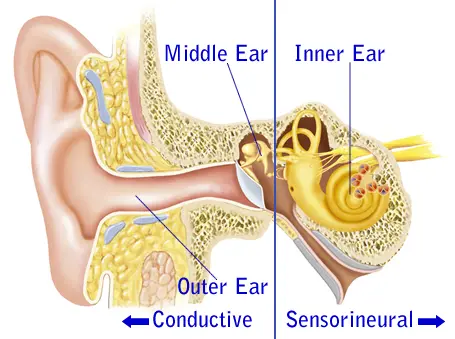Types Of Hearing Loss
There are two different types of hearing impairments, conductive hearing loss and sensorineural hearing loss. A third type is a combination of the two, called a mixed hearing loss. Hearing impairments are categorized by their type – conductive, sensorineural or both, by their severity, and by the age of onset. Furthermore, a hearing impairment may exist in only one ear (unilateral) or in both ears (bilateral).
Conductive Hearing Loss

A conductive hearing loss is present when the sound is not reaching the inner ear, known as the cochlea. This can be due to things such as excess ear wax, external ear canal malformations, dysfunction of the eardrum or malfunction of the bones of the middle ear. The eardrum may have a perforation or disease process resulting in hearing loss of different degrees. Scar tissue formation after ear infections may also cause eardrum dysfunction, and it may be retracted, or sucked into, the middle ear cavity causing loss of effective function.
Dysfunction of the three small bones of the middle ear, the hammer, anvil and stapes may result in conductive hearing loss. The mobility of these bones, or ossicles, may be impaired for different reasons and disruption of the ossicular chain due to trauma, infection or other process may also result in hearing loss.
Many of these conditions can be helped with surgery. A hearing aid is also often a good option for treatment of these conditions. However, in some cases, a conventional hearing aid is not a good choice to correct these types of hearing loss. In some cases, including the patient with no ear canals, a hearing aid would not be a good option. Also, a patient with chronic ear infections and draining ears often cannot tolerate an air-conduction hearing device. In these patients, a direct bone anchored hearing device could be an excellent solution. A titanium implant is placed in the bone behind the external ear and integrates into the bone. A hearing device is clipped on to this titanium implant and conductive hearing is regained.
Sensorineural Hearing Loss
A sensorineural hearing loss is one resulting from dysfunction of the inner ear, the cochlea, the nerve that transmits the impulses from the cochlea to the hearing center in the brain or damage in the brain. The most common reason for sensorineural hearing impairment is damage to the nerve cells in the cochlea, the hair cells. As we grow older the hair cells degenerate and lose their function, and our hearing deteriorates. Depending on the definition it could be estimated that more than 50% of the population over the age of 70 has impaired hearing. Impaired hearing is the most common physical handicap in the industrialized world.
Another common reason for hearing loss due to hair cell damage is noise-induced hearing loss. These types of hearing loss are often most pronounced in the high frequency range. This will often interfere with speech understanding, as it is in the high frequency range that we find the consonant sounds that are most important especially in noisy surroundings. Head trauma, ear infections, tumors and toxic medications such as certain strong antibiotics and chemotherapeutics are other reasons for sensorineural hearing loss.
Hair cells that are damaged cannot be replaced with any surgical procedure. Though significant research with stem cell treatment is presently ongoing, the clinical application of this will not be available for many years. Protection from noise exposure is at present the only way to reduce the hair cell damage. Conventional air conduction hearing aids are often prescribed for patients with sensorineural hearing loss. The outcome with modern types of hearing aids is often excellent, and each individual patient and hearing loss needs special consideration.
Total or near-total sensorineural deafness may be the result of congenital malformations, head trauma, inner ear infection, genetic factors, or long history of excessive noise exposure. In patients with total or near-total deafness, an air conduction aid may not be useful even if the drum and middle ear are normal. In these situations, a cochlear implant is often helpful to help the patient regain hearing. A thin electrode is placed into the cochlea and is stimulated electrically through a small microprocessor under the skin behind the ear. The cochlear implant is the only device that is available to replace a sense that we are either born lacking or lose in our lifetime.
Mixed Hearing Loss
Mixed hearing loss is a combination of the two types of hearing loss discussed above. Chronic ear infection can result in a defective eardrum or middle ear cavity, and often in addition to the conuctive hearing loss the individual may have a sensorineural hearing impairment. The optimal treatment for this type of hearing loss requires consideration of all of the factors involved and must be individualized for the patient. The option of hearing aids versus reconstruction of the middle ear hearing mechanism is considered on a case by case basis.

